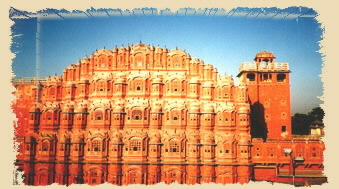
| JAIPUR |
 The rose-pink capital of
Rajasthan, is surrounded on all sides by rugged hills, crowned with forts. Enclosed
by embattled walls, the city was built early in the eighteenth century. The
Maharaja’s palace stands in the centre of the city amidst lovely gardens. Houses with
latticed windows line the streets, their rose-pink colour lending enchantment to the scene
and almost magical at sunset. Jaipur is aptly called the "Pink City of India".
It takes its name from the famous Maharana Sawai Jai Singh, who founded the city in 1728.
A keen astronomer, he built an observatory which still exists and is equipped with quaint
masonry instruments of remarkable size.
The rose-pink capital of
Rajasthan, is surrounded on all sides by rugged hills, crowned with forts. Enclosed
by embattled walls, the city was built early in the eighteenth century. The
Maharaja’s palace stands in the centre of the city amidst lovely gardens. Houses with
latticed windows line the streets, their rose-pink colour lending enchantment to the scene
and almost magical at sunset. Jaipur is aptly called the "Pink City of India".
It takes its name from the famous Maharana Sawai Jai Singh, who founded the city in 1728.
A keen astronomer, he built an observatory which still exists and is equipped with quaint
masonry instruments of remarkable size.
Jaipur is noted for its craftsmen skilled in the art of cutting precious stones and famed for its garnets and rubies. It is equally well known for brass inlay work, lacquer work and the printing of muslims.
CITY SIGHTSEEING : The City Palace which now houses a museum containing rare manuscripts, painting and an armoury; the Observatory - built in the 17th century by Jai Singh - with a sundial 90 ft. high; the Museum amidst the Ram Niwas Palace Gardens founded in 1876 with a large collection of antiques; the Palace of Winds, a landmark of Jaipur made of pink sandstone and of unique design. Drive around the Pink city.
AMBER : 12 kms (7 miles) from Jaipur, lies Amber with an old palace overlooking the lake at the entrance to a rocky mountain grove. Built in the 17th century, the palace is a distinguished specimen of Rajput architecture. The Jai Mandir (Hall of Victory) is so delicately ornamented with fine inlay work that it glows. The fort of Jaigarh, crowning the summit of a peak is of amazing beauty and grandeur, (Amber Palace and Observatory will remain closed on 26th January, 15th August, 2th October and the day following the Festival of Holi in March). Take a joy ride on elephant back to Amber Fort.
SARISKA : Rajasthan’s outstanding sanctuary rich in wildlife.
Sariska
possesses great scenic beauty and the wildlife consists of sambhar, four-horned antelop,
wild boar, spotted deer, chinkara, hyena, porcupine and rabbit. Tiger and leopard are
common and can be conveniently seen from observation towers. For bird watchers, the
sanctuary is even more interesting as partridge, quail, sandgrouse, peacock and green
pigeon move freely on the roads. There is a Forest Rest House as well as a Palace Hotel.
(Best period - October to June.)
| JODHPUR |
Jodhpur stands on a range of sandstone
hills surrounded by a strong wall nearly 10 kms (6 miles) in length, with seven gates.
Dominating the city is an eminence surmounted by a massive fortress. In olden days, the
fortress must have been well nigh impregnable, for the rocky base on which it is built is
scraped on every side. Within the walls are royal palaces of old, with priceless jewels
and a striking collection of arms. Sightseeing of Jodhpur includes visits to Fort,
Palaces, Armoury and Jaswant Tara.
MANDORE : About 8 kms to the north of Jodhpur is Mandore, the old capital of Marwar, abandoned for strategic reasons. The gardens at the foot of the hill have commemorative cenotaphs of the former rulers of Jodhpur. The shrine of 330 million gods is an interesting sight. In the hall of Heroes, is a group of colossal figures carved out of a single rock.
OSIAN : 67 kms (42 miles) from Jodhpur towards the north-west, Osian has 16 Jain and Vaishnava temples dating back from 8th to 11th centuries presenting the grandeur of Indian temple architecture. All the sixteen temples are within the outer limit of the village.